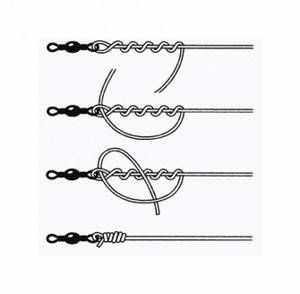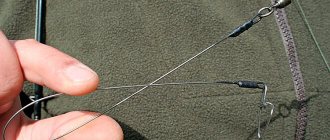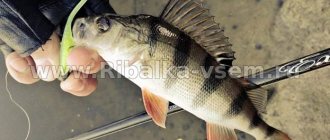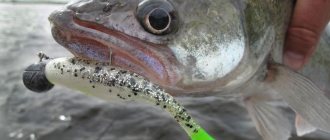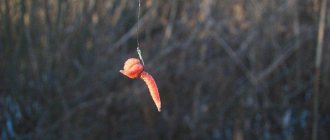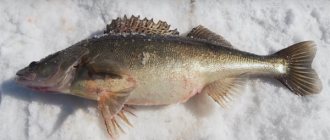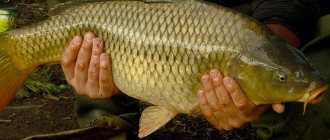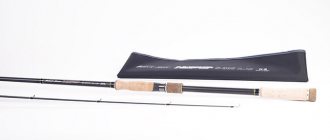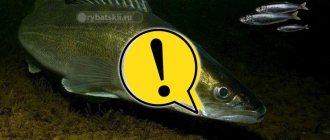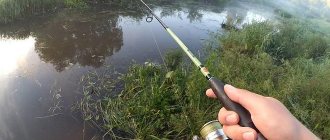Fishing with live bait
Are you planning to catch pike perch with live bait, but don’t know what hook to use to catch it? No problem! The site catcher.fish will tell you which hook is used to catch pike perch using a float rod, a jig or other live bait tackle.
There are no special requirements for selecting a hook for pike perch, but still, there are some points that are important to know and that will make your catching of a predator better.
All the information can be contained in literally a couple of paragraphs, so it won’t take much of your time.
So, if we talk about catching pike perch with live bait, then a single hook, a double hook or a treble hook can be used. Each of them has its pros and cons, and must also have certain characteristics. Let's look at everything in order.
What kind of bait should it be?
Catching a predator with live bait, like any other type of fishing, has its own characteristics, one of which is the presence of live bait. You should always remember that pike perch can only be interested in live and actively moving fish . Usually pike perch attacks live bait from ambushes, with lightning speed, mainly in the dark. Inanimate, and even more so, stale bait will not attract him.
Always give preference to fry of those species of fish that can be found in the reservoir where you are going for pike perch.
The smartest thing to do is to get live bait immediately upon arrival at the fishing site, before the main fishing, which is easy to do using a float rod equipped with a small hook, or using a “baby fisher” , which must be carefully lowered into the water to a depth of about a meter, and any food should be poured on top. . After about 10 - 15 minutes, small fish will gather in the area of your “little fish” and can be picked up. After this, pike perch can be caught using the fry that has just been stocked.
The most attractive to predators are the following types of small fish:
- Roach fry.
- Small crucian carp.
- Chub.
- Bleak and top melting.
The average size of prepared live bait should be 8 – 12 centimeters . Both medium and large pike perch can be tempted by such a fish. The main thing is that it should be fresh and active.
Catching pike perch with live bait in the summer is complicated precisely by the fact that you need to be able to keep the bait fresh at high temperatures, which can sometimes be quite difficult. To do this, you need to change the water in the container in which you store live bait more often, do not leave it in the open sun, and, if possible, keep the temperature of this water low.
Single hook for zander
A single hook has the main advantage over a double or treble hook, which is that it is the least noticeable; when used, the predator is not afraid to attack live bait.
Also, due to the fact that a single hook has only one sting, if a pike perch pricks itself on it, it will only be when it has already gotten a good hook.
In general, a single hook is good because pike perch bites on it are always the most confident.
A single hook also has disadvantages, because it only has one sting, and this sometimes leads to the fact that the predator does not sit securely enough on the hook or attacks the fish from the wrong side on which the hook sting is located.
A single hook can be used when catching pike perch using mugs or girders, and for vertical fishing it is best to use a jig head with live bait attached to it.
The optimal jig head size for catching pike perch is No. 2/0, 3/0. Take a regular single hook from No. 1-4 according to the European classification. Choose hooks with a long shank, they are much more convenient and practical.
Composition of bottom tackle for pike perch
As mentioned above, there are several main types of bottom tackle. Here we will talk about one of them, which is the most common.
- Fishing rod . It is believed that a fishing rod for bottom fishing should not be longer than 2.5-3 m. If we are talking about a reservoir where there is a weak current or no current at all, then a test characteristic of 40-60 grams is quite suitable. If we are talking about areas with strong currents, then the requirements will be higher - a test of 100 grams will be required.
- Reel _ As mentioned above, a reel can be used for bottom fishing, but there are also options when it is not used. Now we are talking specifically about spinning bottom fishing. In this case, a spinning reel with a spool rating of 3000 is most suitable. It will be great if this model has a drag and a “baitrunner” system.
- Fishing line . Considering the fact that when bottom fishing for pike perch, they rely on fairly large fish, you need to take the appropriate fishing line. Its thickness should, as a rule, be at least 0.35 mm.
- Feeder . Using a feeder when bottom fishing is very effective. It simultaneously feeds fish and acts as a sinker when casting. If you choose the right type of feeder, it will lock in the right place after being thrown.
Double for zander
A double hook for catching pike perch will be the golden mean, which is located between a neat single hook and a so-so harsh tee, which practically does not forgive the predator’s mistakes.
A double hook does not cause any particular danger to the fish, like a tee, and, at the same time, a double hook is more reliable than a single hook in terms of the quality of hooking fish.
Single bites or fish leaving a double hook happen less frequently than with a single hook, since the double hook has a higher chance of successfully hooking the fish when biting.
For catching pike perch, choose double hooks No. 1-4, as well as single hooks. It’s also better to choose doubles with a long fore-end - it’s easier to put on live bait, and it will be easier to pull the double out of the pike perch’s mouth later.
There are doubles for catching pike perch, in which one hook is smaller than the other. The smaller hook is used to attach live bait, and due to the fact that this hook is smaller and thinner, live bait receives less injury when hooked and remains active longer.
Spinning or donka
In the spring, pike perch, hungry over the winter, rushes at everything that moves. This is the best time for spinning fishing. Donks are ineffective at this time. Then the fanged predator begins spawning, after which it rests for 10-15 days: fishing at this time is useless.
But after resting, the fish becomes active again and starts hunting. In spring it is better to use small and light baits. The length of the rod must be at least 3 m, and the thickness of the fishing line - 0.15-0.2 mm.
Summer time is also suitable for spinning fishing. At this time, it is better to use a wobbler or spinner that goes 0.5-2 m deep: with their help it is easy to “feel” moderate temperature layers in order to search for schools of pike perch.
For bait, it is best to use a jig with a foam head or a retractable leash with a twister bait.
In autumn, the water temperature drops and pike perch dives to a depth of 5 m and below. During this period, dull baits with a narrow cross-section and wobblers with deep depth should be used for fishing.
At this time, it is better to use bottom tackle for pike perch - a feeder. This is an active bottom method of fishing, in which first, complementary feeding is carried out at selected points in the water area, and then bottom equipment is placed in these places. It includes:
- feeder rod;
- feeder equipment consisting of a leash, a hook and a feeding weight;
- non-stretch braided line;
- spinning reel.
The advantages of this fishing method include:
- the possibility of spot fishing at a great distance from the shore;
- increased chances of success, because at depth the fish feels safe and is more willing to swallow the bait;
- high sensitivity of the gear to bite.
The disadvantages of this fishing method include:
- the process is highly labor-intensive: it is necessary to constantly move feeders and change baits;
- high technical requirements for equipment.
Tee for zander
The tee will rarely let the pike perch leave if it has already taken a bite, so in this regard it is the absolute leader.
The only downside of the tee is that it is quite noticeable; the pike perch can be alarmed by such a hook and a bite will not occur.
Also, the likelihood that a pike perch will prick itself on one of the stings of the tee is much higher, and this may cause the pike perch to not take live bait and swim away.
Of course, a huge advantage of a tee is that the realization of bites with it will almost always be 100%. The fish has practically no chance of escape, because the tee very reliably sticks into its mouth with several stings at once.
The size of the tee for pike perch is also selected No. 1-4 with a long shank. And it is best to take tees, in which one of the hooks is also smaller and thinner, like the doubles described above.
Habitats
This fish prefers places where the water is saturated with oxygen. This is one of the reasons that in the middle of winter there is practically no bite for this fish. At this time, the water is very poor in oxygen.
Since this is, as is well known, a bottom-dwelling fish, its habitats are located there, the deepest places. In small areas, pike perch avoids looking for food.
After spawning, this fish tries to go deeper. At this time, her behavior is completely different from the feeding that occurred for months before spawning.
You can catch pike perch in winter, but you need to do it where it lives. Most often, such places are characterized by relatively warm water. For example, we can talk about water that is associated with runoff from cities, for example.
What hooks are considered reliable?
Among the many manufacturers of hooks, both single and doubles with tees, you can find all sorts of them - both those that can be bent or broken with your fingers, and those that are difficult to attach a nozzle to because they are absolutely dull.
To help you avoid purchasing low-quality hooks, catcher.fish has decided to list you fishing hook manufacturers that you can trust.
These hooks are perfect for catching pike perch. Choose such hook manufacturers as:
- Cobra;
- Gamakatsu;
- Owner;
- Mustad;
- Hayabusa;
- Saikyo;
- Kamasan.
These manufacturers have proven themselves in the market for a very long time, they will not spoil their reputation with low-quality products, so you can always rely on the hooks of these companies - they are sharp and strong.
In conclusion, I would like to say that it is best to use doubles for catching pike perch, especially if you have little fishing experience. As you gain more experience, you will be able to determine for yourself whether to use a treble hook or a single hook in a particular case, depending on the activity and alertness of the predator. And the double is universal, so it’s ideal for almost any situation.
What to fish from the shore?
For fishing from the shore, a spinning rod or a simple float rod is suitable. Pike perch does not swim close to the shore, but stays at a distance of several tens of meters from it.
Therefore, whatever the type of fishing rod for pike perch, it must be capable of long casting (up to 50 m) and have a powerful and high-quality reel for fishing.
In addition, you need to choose the right:
- Place. The best are:
- rocky bottom with good depth;
- rocky rifts;
- small whirlpools;
- water areas with good current.
- Bait. It can be anything - twister, foam rubber, vibrating tail, but of the smallest size. A large bait will not allow itself to be cast a sufficient distance.
- Fishing position. The best position for fishing from the shore is the top of the coastal edge. For this purpose, you will need waders or a chest-length rubber suit.
From the boat
Trolling is a type of spinning fishing from motor boats.
Its advantages include:
- quick reconnaissance of a river or reservoir;
- I fish in inaccessible places;
- selection of wiring depth;
- accuracy of moving the bait along the edge;
- simultaneous use of several gears.
This type of fishing also has disadvantages:
- fishing is limited to clean areas of water bodies;
- gear and equipment (motor boat equipped with an echo sounder, navigator, angler safety features, etc.) are too expensive.
Trolling requires the purchase of additional gear for catching pike perch:
- a special fishing rod with which you can attach a side fishing rod (spinning rod);
- reels of inertia-free models;
- special trolling baits (spinners, jig baits, large wobblers);
- braided fishing line with a metal leash;
- devices for spreading several gears in different directions and for scattering baits in the water column.
You can also fish from a boat using a feeder.
The best winter lures for pike perch
The winter lures listed below are not uniquely effective in all conditions. As a rule, even among identical spinners from a well-known company, there may be two, of which one regularly catches pike perch, but the second cannot be caught at all.
Read also: Doesn’t bite? Let's catch pike perch using sprat!
This is due to features of the game that are invisible to the human eye and ear, because fish see the world somewhat differently than we do. When a catchy winter spinner is found, it’s worth fishing with it, but if it comes off, it’s not a fact that among the spinners of the same type there will be an equally catchy one.
Rating of the Top 10 best spinners for winter pike perch with photos:
- Carnation. Pike perch classic. It is a spinner with a smooth, oblong, oval-shaped body that has an extension at the bottom. The game is simple - the spoon simply rises up and falls down with minor deviations from the axis and vibrations. Any game at great depth turns into a “stud” in the game, so you should not succumb to the inexpressiveness of its play. However, in some cases the spoon is not very catchy.
- Diamond. The body of the spinner is a convex symmetrical rhombus with an apex in the middle; soldering is done on the back side or the same diamond is placed. The spinner has a more expressive action than the nail, as well as a more consistent and repeatable action.
- Triangular. Similar to a diamond in shape, but asymmetrical. It differs from a diamond in that instead of a tip, there is an edge in the middle from the attachment point to the hook, the sides of the main sheet are strongly bent, and lead is poured on the back side. The advantage is a clear, repeatable and expressive game, stable hooking of fish and the ability to “knock” on the bottom.
- Reverse triangular. It differs in that the heavier part is at the top. It differs from the usual more stable and more vertical game, which, however, is not always good and does not allow you to fish the area around the hole.
- Tube. There is a whole class of anglers who catch pike perch exclusively with a tube. Such a spinner is hollow inside and creates acoustic vibrations that are perceived in a special way by fish. Shows itself well on “bleak” reservoirs. Disadvantages - among the same spinners, very often there are elusive ones, even those manufactured by the factory method; in reservoirs where pike perch bites after hitting the bottom, they do not work well.
- Sealed tube. Allows you to play better at great depths and clearly tap the bottom, but at shallow depths preference should be given to a regular tube.
- Shoe. The front of the spinner is of the same type as the carnation, and in profile it has an S-shaped bend with soldering, which makes it somewhat similar to a woman’s shoe. The game is quite bright and expressive, creates small vibrations, and allows you to fish a significant area around the hole. The disadvantage is that sometimes the pike bites and tears off the spoon.
- The ski is Vlasov. A spinner that has a bend in the lower part in the form of a ski sock, where there is lead soldering and hooks are soldered in. Often this lure is equipped with a hook on a chain. It has the same advantages and disadvantages as the slipper, but less fractional play.
- Oscillator. It is very similar to a summer spinnerbait, made of thick metal without soldering, with the same thickness over the entire area. Has a fairly fractional game. Disadvantage - often spinners of this type do not have a clear, repeatable game, and are also insufficient for fishing at depth.
- "Castmaster". The spoon is similar to the summer castmaster, but is thicker. It has the same advantages and disadvantages as the “oscillator”, but is more suitable for fishing at depth and the game is less fractional.
How to tie a lead leash for pike perch?
To make gear of this kind you need high-quality fishing line, sinkers, and bait. You can create reliable tackle using at least three options:
- No. 1 - the sinker is tied to the end of the main line. The leash is made from a piece of fishing line up to 1.2 m. It is equipped with offset type hooks. A knot loop is formed at the opposite end of the main line. The leash is fixed to the base 1 m from the sinker. Installation is recommended to be done through a swivel.
- No. 2 is a mirror image of the first option. Everything is done identically. Only the hook with bait and the weight change places. The main disadvantage of this kind of gear is the possibility of losing the equipment when hooked.
- No. 3 – the method involves the use of a double or triple swivel. It is this that is attached to the main line. Next, two leashes of less thickness than the main line are formed. The length of the leash for pike perch in this case is 1 m. An offset with bait is located on one additional element. On the second leash there is a sinker. The second ends of both elements end in a loop. They are connected to each other with a swivel, using the loop-to-loop method.
Knots play a huge role in creating gear of this kind. After all, they are the ones who securely fasten all the elements of the leashes. Experienced fishermen use several methods of tying knots. Varieties are divided into two main types: sliding and stationary.
How to make a diverting leash for pike perch photo - knots
